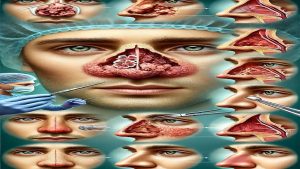Repair of injuries caused by bacterial or fungal infections
Introduction
The nose plays an essential role in respiratory function, sense of smell, and facial appearance. However, severe bacterial or fungal infections can be destroyed by nasal tissue, deformity (Badness) And disruption to respiratory dysfunction. Nasal reconstruction after these injuries has complex challenges because it has a 3D and sensitive structural nose that needs to be successful and highly skilled to reconstruct the surgical care.. In this article from the site of Dr. Behnam Khorrami (Isfahan nose surgeon _ Jaw surgeon of Isfahan)Examines the causes, surgical processes, and nasal regeneration techniques after severe infections.
1.. Causes and causes of severe nasal infections
Ыұ.Ыұ. Bacterial infections
Severe bacterial infections can cause necrosis (Tissue death), Swelling and forming an abscess. One of the common bacteria that can lead to severe nose infection is:
Staphylococcus aureus (Staphylococcus aureus)
Streptococcus Pygenz (Streptococcus pyogenes)
Pseudomonas aeroginosa (Pseudomonas aeruginosa)
Ыұ.ЫІ. Fungal infections
Fungal infections, especially in people with immune system weaknesses (Such as diabetic patients, cancer patients, or people treated with immune suppressing drugs) Can cause nasal tissue necrosis. The most common pathogenic fungi are:
Moro (Mucor)
Aspergillus (Aspergillus)
Candidate (Candida)
Ыұ.Ыі. Talented factors
Diabetes is not controlled
Immune defect (HIV, Cancer, Immunosepingo Drugs)
A history of surgery or trauma to the nose
Long -term use of steroids
Healthy conditions
2.. Damage caused by severe infections
ЫІ.Ыұ. Soft tissue damage
Severe bacterial or fungal infections can lead to:
Swelling
Necrosis (Tissue death)
Fistula formation (Abnormal relationship between nasal cavity and other spaces)
ЫІ.ЫІ. Structural damage
Severe infections can damage the following structures:
nasal septum вҶ’ septum deviation and respiratory problems
Cartilage вҶ’ Deformiti (For example Sadde Nose)
Skin and soft tissue вҶ’ thinning and disappearing of nose skin
Ыі. Initial diagnosis and evaluation
Ыі.Ыұ. Clinical examination
Assessing the shape and function of the nose
Airway blockage check
Evaluation
Ыі.ЫІ. Imaging tests
CT Scan (CT Scan) вҶ’ to evaluate the amount of bone destruction
MRI вҶ’ To check for soft tissue damage and blood vessels
Ыі.Ыі. Cultivation and biopsy
Sampling of damaged tissue to diagnose the type of infectious agent (Bacteria or fungus)
An antibiotic sensitivity test
4.. Stages of nasal regeneration after severe infections
Ыҙ.Ыұ. first stage: Infection control
At this stage, the goal is to prevent infection progress and maintain healthy tissue:
Antibiotic or antifungal treatment based on cultivation results
Surgical debris (Removing necrotic tissue)
Control of underlying factors (Such as control of blood glucose in diabetes)
Ыҙ.ЫІ. second stage: Structural reconstruction
After complete control of the infection, the reconstruction phase begins:
Ыҙ.ЫІ.Ыұ. Rather, it is enlarging the nose by creating a bridge over the nose
Cartilage from nasal septum (If it is healthy), Lifted ear or ribs and used to rebuild the nasal framework.
Ыҙ.ЫІ.ЫІ. Soft tissue transplant
The use of topical flaps (Local Flaps)
Use free flaps (Free Flaps) From the forehead or species area
Ыҙ.ЫІ.Ыі. Regeneration
Using the mucous membrane or soft tissue transplant to regenerate the inner surface of the nose
Ыҙ.Ыі. third level: Cosmetic and functional regeneration
At this point focus is on improving the appearance of the nose and respiratory function:
Ш¬ШұШ§ШӯЫҢ ШІЫҢШЁШ§ЫҢЫҢ (ШұЫҢЩҶЩҲЩҫЩ„Ш§ШіШӘЫҢ) вҶ’ to correct nose form
Skin transplant вҶ’ to improve the appearance of nasal skin surface
5. Common techniques in nose reconstruction
Ыө.Ыұ. Forehead flap (Forehead Flap)
This method is used to regenerate nose skin.
The forehead tissue is selected because of the color and thickness of the nose..
Ыө.ЫІ. Flap Paramadian Flap (Paramedian Forehead Flap)
Used for deep and extensive repair.
Enables accurate regeneration of nose and side walls.
Ыө.Ыі. Transplantation of gear cartilage (Costal Cartilage Graft)
In cases where septum cartilage and ear cartilage are inadequate, gear cartilage is used.
The high strength and capability of this cartilage make it suitable for regenerating the nasal framework..
Ы¶. Possible problems and complications
Secondary infection
Bond rejection
Change the shape of the nose
Nasal obstruction
Ы·. Results and prognosis
Successful nasal reconstruction depends on the surgeon's skill, postoperative care and general condition of the patient.
Using new surgical and tissue transplant techniques has increased success rates.
Most patients experience improvement of respiratory function and normal nose appearance after successful regeneration..
Ыё. Conclusion
Nasal reconstruction after severe infections is a complex and multi -step process that cooperates with the Ear and Nose Specialists. (ENT), Plastic surgeons and infectious specialists need. Success in these reconstructions, in addition to the surgeon's skill, depends on the strict control of infection, careful planning and the use of advanced surgical techniques..
Useful links:
Isfahan nose surgeon _ Jaw surgeon of Isfahan
Dr. Behnam Khorrami's page in the clinic 24 | Maxillofacial surgeon in Isfahan clinic 24 | Nose surgeon in Isfahan clinic 24
Dr. Behnam Khorrami, nose surgeon in Isfahan at Dr. Af | Maxillofacial surgeon in Isfahan at Dr. Af | Isfahan nose surgeon at Dr. Af
